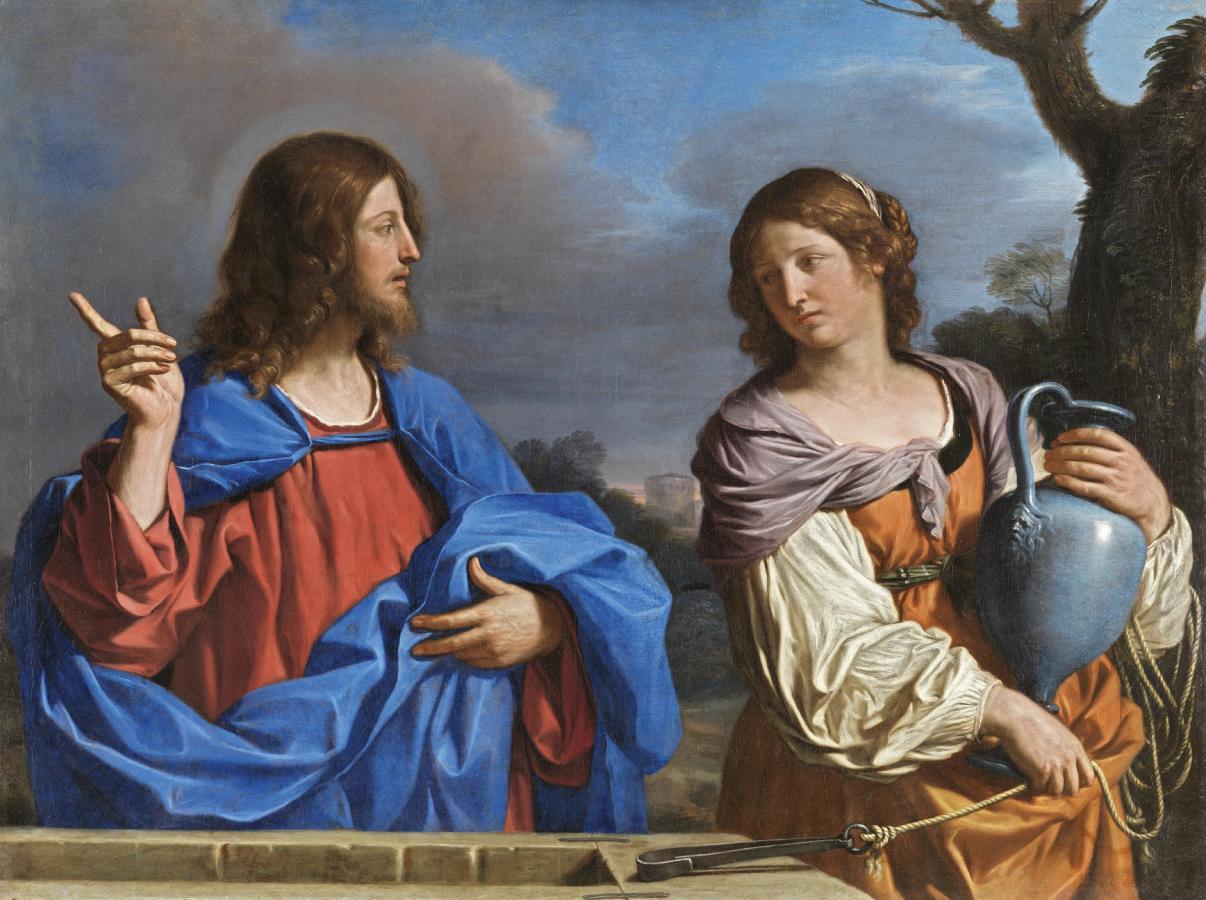Guercino (1591-1666)
Cristo e la donna di Samaria al pozzo (Christ and the Woman of Samaria at the Well)
c.1640–1641
Oil on canvas, 116 x 156 cm
Museo Thyssen-Bornemisza, Madrid
The meeting between Christ and the woman of Samaria at the well is only recounted in the Gospel of Saint John. Christ, travelling to Galilee, reached the Samarian city of Sychar. While the disciples went ahead into the city to buy food, Christ sat down to rest by a fountain. A woman approached the well to draw water and Christ requested water to drink. Surprised, the woman questioned why a Jew was asking her for water, given that Samaritans and Jews had no dealings with each other. The woman, who had had five husbands and lived with a man (as Christ knew), began a dialogue with him that astonished the disciples when they returned to the city, as it was not the custom to speak to unknown women. This episode, which takes place by a well and in which the water of baptism is discussed, has been seen to symbolise the conversion of gentiles by the Word, among other concepts.
The subject of Christ and the Woman of Samaria is mentioned three times in Guercino’s Libro dei conti, which records his compositions and commissions with their corresponding payments and which was maintained by the artist’s brother Paolo Antonio until his death in 1649 and then by other members of the artist’s workshop. The identification of the present canvas in this document was suggested by Carlo Volpe in a letter and published for the first time by Gertrude Borghero in the catalogues of the Collection. The present painting has been identified as the one described in entry 216 in the account book, which was painted for Giuseppe Baroni of Lucca and for which Baroni paid 100 ducats. Baroni paid in two instalments, firstly 30 ducats on 22 March 1640, then 70 ducats on 14 November of the same year. In both cases he used the same intermediary, Lorenzo Paoli. Another painting on this subject appears in the account book as entry number 254. It belonged to the Abbot Bentivoglio and also cost 100 ducats. This is the version now in the National Gallery of Canada, Ottawa, which was paid for on 29 May 1641. The third work on the subject of the Samaritan woman recorded in the account book was painted for Girolamo Panesi and has been identified as the oil in the collection of the Banco di San Geminiano e San Prospero in Modena.
Guercino’s canvas depicts a moment in the conversation between Christ and the Samaritan. The two figures, depicted half-length and in the foreground, are positioned around the well-head at which the Samaritan woman has arrived with her pitcher. The encounter takes place on the outskirts of the city and is set in a tranquil landscape in which the sky is given considerable importance, with its horizontal banks of broken clouds. The composition reveals Guercino’s complete mastery of the language of gestures and expressions, for example, the mistrustful expression of the woman towards the stranger talking to her, and Christ’s pose, which is particularly expressive through the use of the profile position of the head and the way his presence is emphasised by the movement and gesture of his right hand. In this balanced, classicising composition Guercino paid considerable attention to secondary details such as the pitcher, the rope of the well, the hook and the stones of the well-head, all of which are finely painted. He was also interested in achieving a realistic depiction of the textures of the figures’ garments.
The figures are highly idealised, and the figure of the Samaritan woman appears in other compositions by the artist, among them the figure of the Virgin in a painting in the church of San Martino in Senigallia.
The painting entered the Thyssen-Bornemisza collection in 1976 from that of the Marquis dal Pozzo in Milan.
Mar Borobia (T-B)
